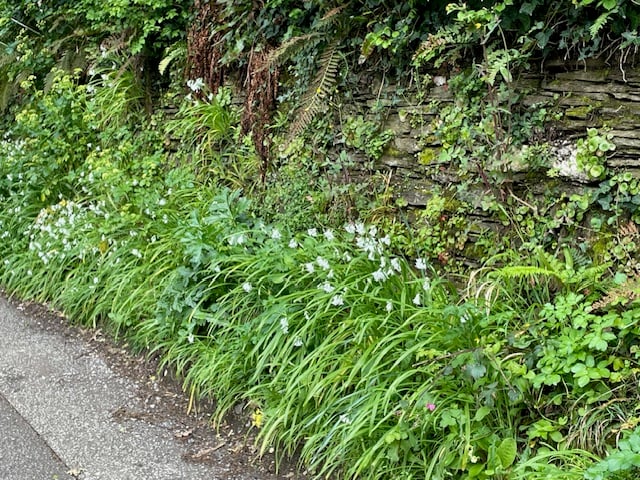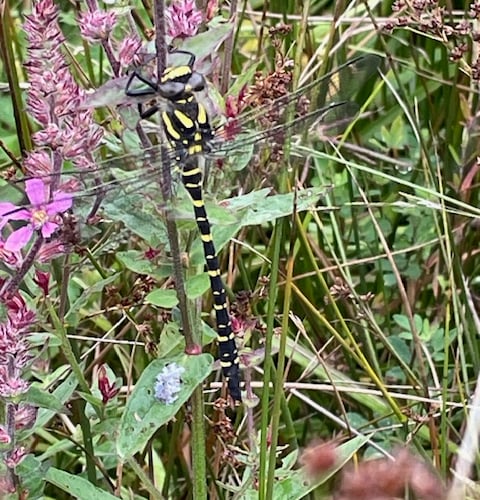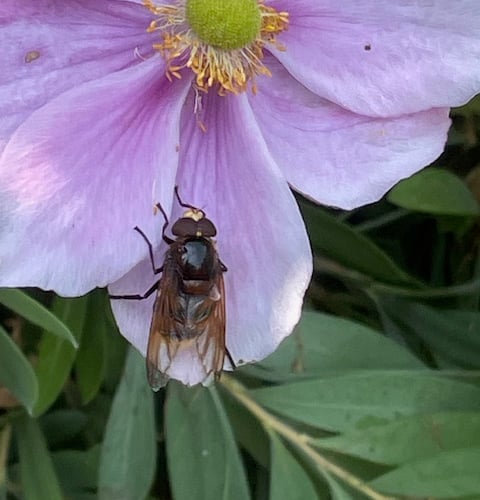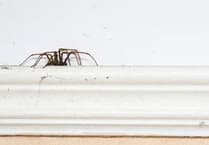It seems to be official that our climate has indeed changed over the past few decades. There is no doubt that locally we are swinging from flood to drought and back again. We have certainly lost garden trees that we planted twenty years ago. One minute they are growing prolifically in all the rain and the next they’re dead in the ensuing drought, probably not quite the conditions in the high mountain valleys from which they originated. However, some alien plants are not only thriving but, in some cases, are even being classified as invasive and their planting restricted.
In Slapton there have always been self-seeded flowering plants growing along the bases of the walls. Some new arrivals, like the small, blue-flowered campanulas, seem welcome additions to me, but two have become quite rampant. A good few years ago now, there was a television programme featuring the “Yorkshire Gardener” who toured the country commentating on the gardens and roadside plants she encountered on her travels. I remember vividly her getting her driver to stop the car to allow her to inspect a “Three Cornered Leek” growing in a hedgerow and which she viewed as a rarity. At that time, we just had a small patch of this Mediterranean plant growing by the telephone box in Slapton. Since then, it has marched with increasing enthusiasm around the village, to become perhaps the most common Springtime plant; it spreads both by seed and bulbils. “Oh look”, I have heard visitors say, “white bluebells”.

The other plant that has been so successful in the village is the Mexican Fleabane, a native of Central America and popular in some gardens because of its long flowering season. Twenty years ago, it was found on the roadside only in the very centre of the village, but it soon started to spread along the road edges. We were spared it for a long while on our hillside, but it finally found its way in through the gate and now populates almost every crack and crevice in our stone walls and paving throughout the garden. It only seems to attract the smallest of pollinators, tiny flies and hover flies, and equally small solitary wasps.
These successful plants seem to tolerate both the wet and the dry, but many of our animals and plants can’t cope with these wild variations. As a representative of the Wildlife Trusts said the other day, “If all the brambles and shrubs fruit early, what will all the mammals and birds feed on in the winter?” Not all are as bright as the squirrels and jays who bury a store of acorns, ready for harder times.

Last year, again, the conditions in our garden were so wet that there was hardly an insect to be seen, be it butterfly or hoverfly. This year, however, the garden has abounded with butterflies, hoverflies, dragonflies, grasshoppers and crickets, and the occasional lizard. In the Spring there were holly blues and speckled wood and comma butterflies aplenty.
In the Summer the garden has been filled with a multitude of meadow browns, gatekeepers and large and small whites, peacocks and red admirals, the odd silver washed fritillary and common blues, including one on my newly-sewed bird foot’s trefoil. We have also had regular visitations from hummingbird hawk moths, but no tortoiseshells, the commonest garden butterfly in my childhood.

Did that terrible wet year cause another flare up in the fungal disease that was affecting them so badly? Hopefully they have not gone forever. Jersey tiger moths in all their splendour have been everywhere, but what has happened to the garden tigers of yesteryear? We have had plenty of the large hoverflies that delight us so much, as well as emperor, golden ringed, southern hawker, chaser and darter dragonflies, plus all the birdsong. Sitting having breakfast in the garden this year has been a delight, so long as we didn’t dwell too long on the state of some our plants.
We know we have a lot of replanting to do, but we need to choose carefully. The plants that have managed to thrive over the past two years may give us a clue.





Comments
This article has no comments yet. Be the first to leave a comment.